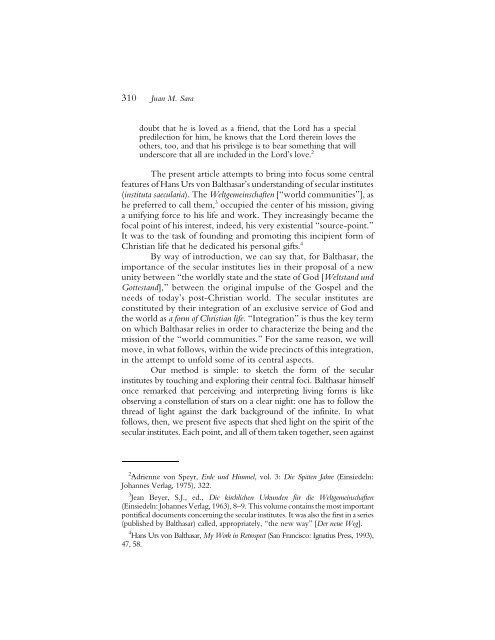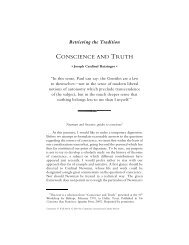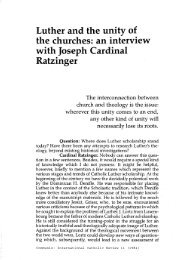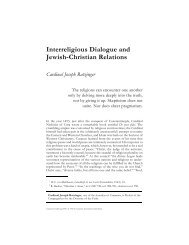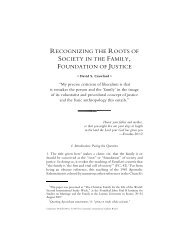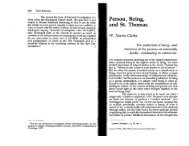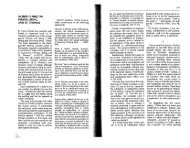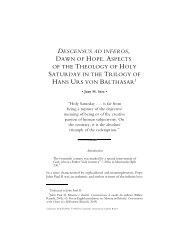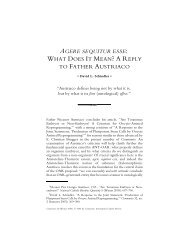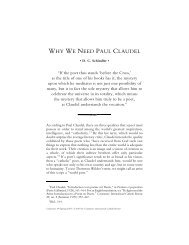Juan Sara. Secular Institutes According to Hans Urs ... - Communio
Juan Sara. Secular Institutes According to Hans Urs ... - Communio
Juan Sara. Secular Institutes According to Hans Urs ... - Communio
You also want an ePaper? Increase the reach of your titles
YUMPU automatically turns print PDFs into web optimized ePapers that Google loves.
310 <strong>Juan</strong> M. <strong>Sara</strong><br />
doubt that he is loved as a friend, that the Lord has a special<br />
predilection for him, he knows that the Lord therein loves the<br />
others, <strong>to</strong>o, and that his privilege is <strong>to</strong> bear something that will<br />
underscore that all are included in the Lord’s love. 2<br />
The present article attempts <strong>to</strong> bring in<strong>to</strong> focus some central<br />
features of <strong>Hans</strong> <strong>Urs</strong> von Balthasar’s understanding of secular institutes<br />
(instituta saecularia). The Weltgemeinschaften [“world communities”], as<br />
he preferred <strong>to</strong> call them, 3 occupied the center of his mission, giving<br />
a unifying force <strong>to</strong> his life and work. They increasingly became the<br />
focal point of his interest, indeed, his very existential “source-point.”<br />
It was <strong>to</strong> the task of founding and promoting this incipient form of<br />
Christian life that he dedicated his personal gifts. 4<br />
By way of introduction, we can say that, for Balthasar, the<br />
importance of the secular institutes lies in their proposal of a new<br />
unity between “the worldly state and the state of God [Weltstand und<br />
Gottestand],” between the original impulse of the Gospel and the<br />
needs of <strong>to</strong>day’s post-Christian world. The secular institutes are<br />
constituted by their integration of an exclusive service of God and<br />
the world as a form of Christian life. “Integration” is thus the key term<br />
on which Balthasar relies in order <strong>to</strong> characterize the being and the<br />
mission of the “world communities.” For the same reason, we will<br />
move, in what follows, within the wide precincts of this integration,<br />
in the attempt <strong>to</strong> unfold some of its central aspects.<br />
Our method is simple: <strong>to</strong> sketch the form of the secular<br />
institutes by <strong>to</strong>uching and exploring their central foci. Balthasar himself<br />
once remarked that perceiving and interpreting living forms is like<br />
observing a constellation of stars on a clear night: one has <strong>to</strong> follow the<br />
thread of light against the dark background of the infinite. In what<br />
follows, then, we present five aspects that shed light on the spirit of the<br />
secular institutes. Each point, and all of them taken <strong>to</strong>gether, seen against<br />
2<br />
Adrienne von Speyr, Erde und Himmel, vol. 3: Die Späten Jahre (Einsiedeln:<br />
Johannes Verlag, 1975), 322.<br />
3<br />
Jean Beyer, S.J., ed., Die kirchlichen Urkunden für die Weltgemeinschaften<br />
(Einsiedeln: Johannes Verlag, 1963), 8–9. This volume contains the most important<br />
pontifical documents concerning the secular institutes. It was also the first in a series<br />
(published by Balthasar) called, appropriately, “the new way” [Der neue Weg].<br />
4<br />
<strong>Hans</strong> <strong>Urs</strong> von Balthasar, My Work in Retrospect (San Francisco: Ignatius Press, 1993),<br />
47, 58.


